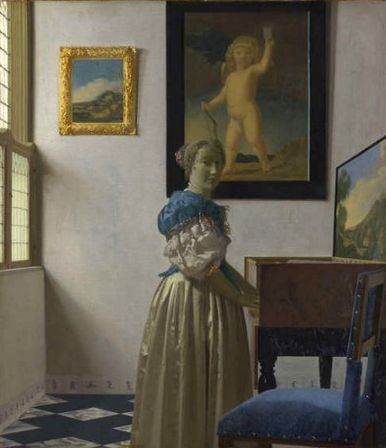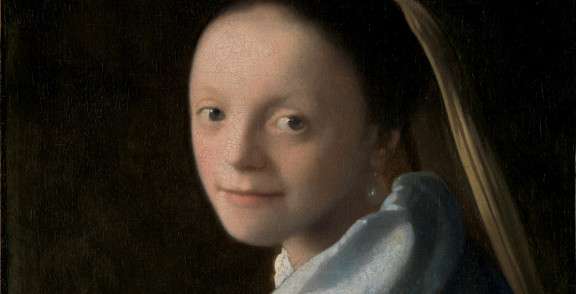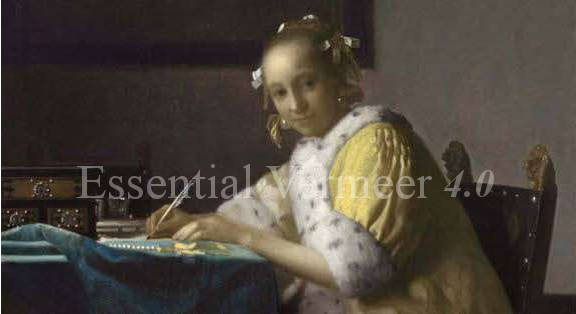Ivan Gaskell has made important contributions our understanding of Vermeer's "inexhaustible art." He is the author of Vermeer's Wager: Speculations on Art History, Theory and Art Museums which stands at the intersection of art history and criticism, philosophy and museology. Any one with an interest in Vermeer and the afterlife of his art will value this book, as will all who think seriously about the role of photography in perception and the core purposes of art museums.
He is also the editor (along with Michiel Jonker) of Vermeer Studies (1998), a fundamental text in which scholars, conservators and scientists investigate Vermeer's art and the milieu in which he worked. This volume offer insight into the current state of understanding of the Dutch master's art and focus special attention on the unique qualities of his paintings.
Mr. Gaskell is currently Margaret S. Winthrop Curator at the Fogg Art Museum, Harvard University.
June 17, 2003

A Lady Standing at a Virginal
Johannes Vermeer
c. 1670–1674
Oil on canvas, 51.7 x 45.2 cm.
National Gallery, London
The Essential Vermeer: In the last half of the twentieth century a significant part of Vermeer studies has attempted to understand the Delft master's art within the context of Dutch seventeenth-century intellectual and cultural life. Which results of these studies do you feel have the most and least satisfying?
Ivan Gaskell: A considerable number of scholars have added to our understanding of Vermeer's art over the last fifty years, so much so, indeed, that it is easy to forget how difficult it had been to reach the point represented by Ary Bob de Vries's 1948 book. I have the utmost respect for the scholars who, from Théophile Thoré onwards, labored to establish an oeuvre out of a bewilderingly varied body of material. What was considered to be Vermeer's art, whether rightly or wrongly, has long attracted interpretive speculation. Some of the early essays-by Gustave Vanzype (1908), for instance-bear careful rereading today. I particularly value the fact that Vermeer's works have attracted commentators who might not otherwise write about visual art. I find it heartening that Vermeer's art prompts articulate responses of many kinds from non-specialists.
Perhaps more than any artist's painting, Vermeer's has been interpreted in a great variety of manners, at times conflicting. What explanation do you give for this?
Vermeer's paintings are "open symbols:" they are characterized by a seemingly purposeful lack of limited specificity in their pictorial allusions. I would suggest that a satisfying interpretation of an artwork is not necessarily the identification of its intrinsic characteristics, but can be the ascription to it of characteristics that are radically extrinsic, yet culturally or otherwise explanatorily plausible. This is the root of canonicity: successive constituencies attribute values to canonical artworks that they can explain, but that may not have been apparent to their predecessors, including, even, their makers.
In 1995 Arthur K. Wheelock Jr. hung the "Saint Praxedis" in the Vermeer Washington/The Hague exhibition, which he believed to be an early work by the Delft master. In the Metropolitan 2001 exhibition Vermeer and the School Delft, Walter Liedtke decided to hang at the last moment the Baron Rolin "Lady Seated at a Virginal" (a work which had by then been almost unanimously excluded from the Vermeer's oeuvre) raising, at least indirectly, the question of its authorship. In Vermeer's Wager (Essays in Art and Culture), you seemed to have dismissed not only the authorship of the "Saint Praxedis" but also the manner in which the proposed authorship was arrived at. What are your feelings in regards to the Baron Rolin work? In the case of Vermeer's painting, what is in your opinion has been the most valid approach for evaluating the authenticity of uncertain works?
I try to keep away from questions of Vermeer connoisseurship, though not because of any disdain. On the contrary, I fail to understand how anyone can usefully discuss an artifact when they don't know what it is they are talking about. If we feel confident that when discussing the Girl Reading a Letter at an Open Window (Dresden) we are discussing a work by Vermeer, we owe that confidence to the work of others (Gustav Waagen in this case)—and I mean work. After all, that painting had once been by Govaert Flinck, and later by Pieter de Hooch (I deliberately avoid "thought to be by"). I am grateful to both Wheelock and Liedtke for showing two problematic paintings in their splendid exhibitions. Those objects served to remind us all that even in the case of an oeuvre as apparently clear-cut as that of Vermeer there are always questions of this kind to be addressed, and that we are the beneficiaries of our predecessors having addressed others.
In "Vermeer Studies" (edited by Dr. Gaskell in 1998) Eddy de Jongh pointed out that although scholars are unanimously in agreement about the elevated stature of Vermeer's work, there is still great doubt as to the iconographic significance that Vermeer may have intended. In your own lucid essay in the same volume, "Vermeer and the Limits of Interpretation," you have faced the matter of understanding Vermeer's "unexceeded elusiveness" by a direct critical, rather than historical, approach to a single painting. Do not both Mr. Jongh's statement, indirectly and your own interpretive approach, directly, imply that perhaps the expressive content of Vermeer's painting cannot be understood from the work's historical context but rather directly from the work itself?
Perhaps the clearest way I can try to address this matter is to distinguish between historical retrieval and historical understanding, the latter term in a special sense that I shall try to explain. Historical retrieval attempts to define a set of notions about an artifact at or near its particular moment of making and initial use (what Michael Baxandall called the "period eye"). Historical understanding would account for the present effects of an artifact in the inevasible light of an entire pattern of past uses. I am aiming at historical understanding rather than at historical retrieval. The latter is an art historical enquiry, and can provide inspiring examples of the retrieval of a past moment. But historical understanding, in the sense I am using the phrase, encompasses a great sequence and even reticulation of the pasts of artifacts as they relate to the present, the very here and now.
This concern with historical understanding follows upon how I see artifacts and history in relation to one another. Responses to artifacts-such as rapture, bewilderment or curiosity-can be expressed in various ways, some mutually supportive, some mutually irreconcilable. My own form of expression-my mode of abstract thought-is history; that is, I seek to explore how things can find a place in history. By history I mean not the past, but what historians make of the past. The past is what has happened. Just as the present is unfathomable in its entirety, so the past is irrecoverable. History is a particular kind of discourse that identifies and makes use of fragmented traces of what has happened, and refers to them in accordance with a set of ever-developing intellectually disciplined conventions. Historians mediate between an ever-shifting present and an ever-receding past. History is the result of acts of translation and creation. Each generation addresses the past-an ever-renewed past-with its own concerns. Each generation (and to an extent each interest group) creates its own history articulating its own ambitions, hopes and warnings. Vermeer's art has a part to play in this ever-developing relationship between all kinds of pasts and the present. When I write about Vermeer's art I do so not as an art historian who seeks historical retrieval, but as a historian who seeks historical understanding.
Your account of Vermeer's "Woman Standing at a Virginal" is masterful in the way it demonstrates the reciprocal, poetic complexity of the work. At times your account seemed redolent of Harold Bloom on Shakespeare. In your view, how wide-ranging was Vermeer's genius, considering especially the concept of "houding" as it bridged pictorial conventions of representation with music, optical perception, and Cartesian/Spinozan concepts of knowing - along with many other cultural referents?
I am very skeptical of the notion of genius, especially as an explanatory device. This is not to say that I believe Vermeer not to have been responsible for the things he made, and-as we know-those things command our attention in various, sometimes seemingly irreconcilable ways. I hope, though, that I demonstrated in Vermeer's Wager that Vermeer was acting in the light of certain identifiable premises about the capacity of visual representation to articulate abstract ideas. Those premises are, I believe, congruent with Cartesian epistemology. However, they are specifically visual, and are articulated exclusively visually, so any links with other discursive manifestations must be extremely delicate, and-to our knowledge to date-remain uncorroborated. I'll stick to conceiving of Vermeer as a thinking maker of visual representations that took a specific physical form, whose grasp of concepts beyond what can be deduced cautiously from those artifacts must remain unfathomable in our present state of knowledge.
In your introduction to "Vermeer Studies," you made a distinction about Vermeer as an individual, a "real" person, and his works as objects in their own right on the one hand, and, on the other, the construction of ideas about each of them which form the basis of a complex field of inquiry. Would you elaborate about this distinction, especially as the answer may shed light on the obligations of and limitations to informed connoisseurship?
Insofar as anyone was, Vermeer was. Insofar as tangible objects of interest are, the things he made are. There is a difference between was and are. Addressing that difference is the historian's responsibility.
Insofar as anyone was, Vermeer was. Insofar as tangible objects of interest are, the things he made are. There is a difference between was and are. Addressing that difference is the historian's responsibility.
Although being beautiful is not a necessary condition of a thing being an artwork, one of the reasons people take an interest in artworks is because they may perceive beauty in them. Beauty is a notoriously slippery concept. It has lost any precision it might once have had, and has become a general term of approbation. It has also suffered from a fear of subscription to normative values on the part of those who, for various good reasons, are suspicious of the inhibiting effect of such values. Philosophers are reviving the study of beauty, and I feel that progress has been such that it need no longer be a taboo topic. I offer a discussion in my chapter, "Beauty" in the second edition of Robert Nelson and Richard Shiff, eds., "Critical Terms for Art History" (Chicago University Press, 2002). The perception of beauty in, or the ascription of beauty to, Vermeer's art is certainly well worth technical (philosophical or otherwise theoretical) examination, though it presents great challenges. On a more colloquial plane, it seems sensible for a scholar to acknowledge an aesthetic, evaluative response (such as finding an artifact beautiful) when to do so materially affects the discussion of it.
In the last two decades, there have been three major exhibits which have Vermeer's painting as their focal point. Briefly, what do feel have been the principal contributions of these exhibitions? Is it possible that such exhibits have any negative side-effects?
Peter Sutton's Masterpieces of Dutch Genre Painting in 1984 offered works by Vermeer as the culmination of this type of painting practice; Arthur K. Wheelock Jr. and Frits Duparc's Vermeer exhibition in 1995–1996 showed a remarkable gathering of his paintings alone; while Walter Liedtke's Vermeer and the Delft School in 2001 placed a large part of his surviving oeuvre (fifteen paintings in the New York version) within a local context of highly varied art production. Each contributed a great deal to my own understanding of Vermeer's art, and I welcomed the opportunity to see his works in a variety of discursive contexts. Complex artifacts do not disclose themselves fully on any single occasion. These scholars and their colleagues gave us priceless opportunities to perceive characteristics of Vermeer's paintings that might not otherwise have been apparent for the very reason that they deployed them in three very different projects, each of which was highly illuminating.
In your opinion, what aspect of Vermeer's art has not been sufficiently investigated? Do the various fields of Vermeer studies, which for the most part have proceeded along lines independently from one another, need to be integrated more successfully among themselves?
I look forward to being surprised by new studies of Vermeer's art on topics I have not yet thought of. I value the great variety of questions and approaches to be found in Vermeer scholarship over several generations, while acknowledging the huge increase in the volume of attention during the last twenty years. I was faced with the problem of having to improvise coherence from a great diversity of material in the volume Vermeer Studies, (1998) that I edited with Michiel Jonker, but I welcomed the diversity of approaches and ideas represented by the contributions. Vermeer's art seems particularly amenable to questioning in a great variety of registers. My only hope is that all who study Vermeer's art and its circumstances might be open-minded about one another's interests. As in Vermeer's interiors, illumination is most often oblique.




 or anything else that isn't working as it should be, I'd love to hear it! Please write me at:
or anything else that isn't working as it should be, I'd love to hear it! Please write me at: